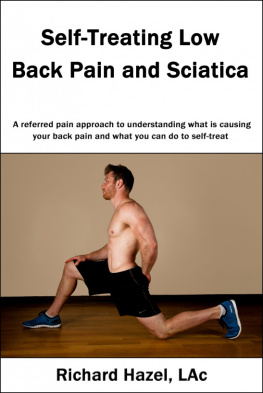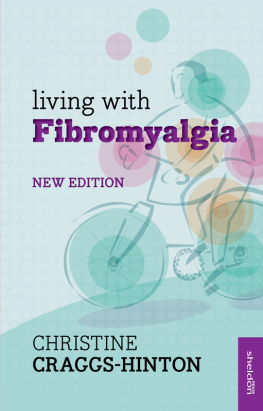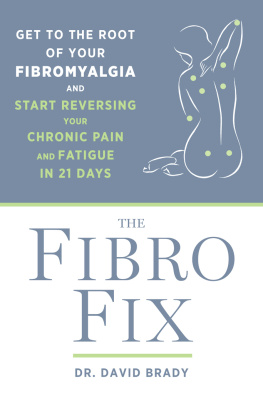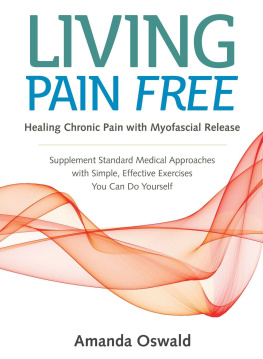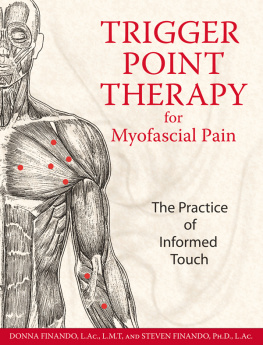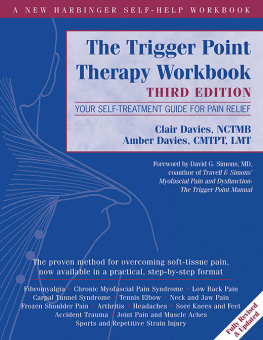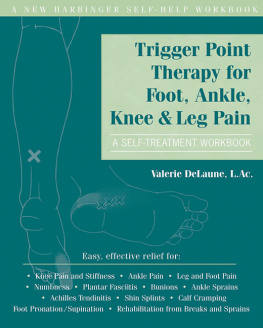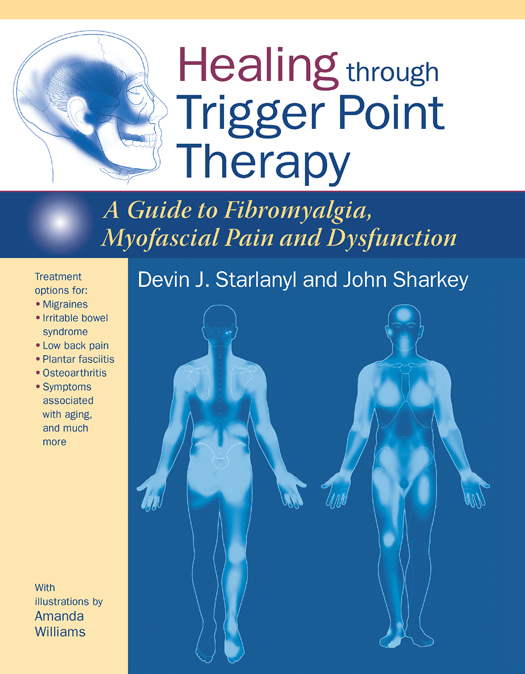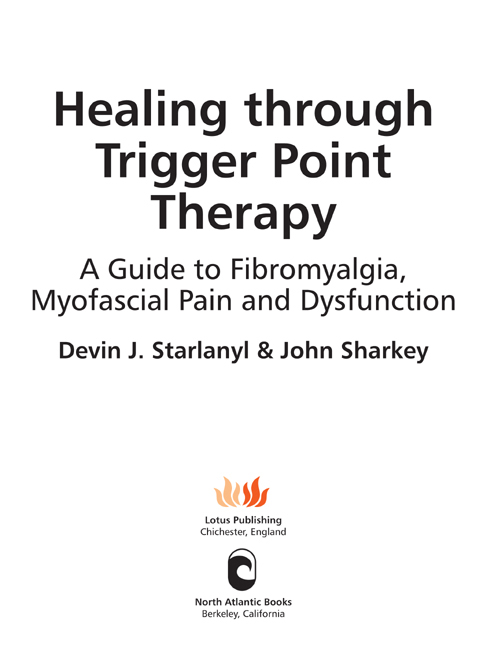eBook ISBN: 978-1-58394-625-1
Copyright 2013 by Devin J. Starlanyl and John Sharkey. All rights reserved. No portion of this book, except for brief reviews, may be reproduced, stored in a retrieval system, or transmitted in any form or by any means electronic, mechanical, photocopying, recording, or otherwise without the written permission of the publisher. For information, contact Lotus Publishing or North Atlantic Books.
First published in 2013 by
Lotus Publishing
Apple Tree Cottage, Inlands Road, Nutbourne, Chichester, PO18 8RJ and
North Atlantic Books
P.O. Box 12327
Berkeley, California 94712
Illustrations Amanda Williams
Text Design Wendy Craig
Cover Design Paula Morrison
Acknowledgements
Healing through Trigger Point Therapy: A Guide to Fibromyalgia, Myofascial Pain and Dysfunction is sponsored by the Society for the Study of Native Arts and Sciences, a nonprofit educational corporation whose goals are to develop an educational and cross-cultural perspective linking various scientific, social, and artistic fields; to nurture a holistic view of arts, sciences, humanities, and healing; and to publish and distribute literature on the relationship of mind, body, and nature.
British Library Cataloguing-in-Publication Data
A CIP record for this book is available from the British Library
Trade Paperback ISBN: 978-1-905367-39-9 (Lotus Publishing)
Trade Paperback ISBN: 978-1-58394-609-1 (North Atlantic Books)
Library of Congress Cataloguing-in-Publication Data
Starlanyl, Devin.
Healing through trigger point therapy : a guide to fibromyalgia, myofascial pain and dysfunction / Devin J. Starlanyl and John Sharkey.
p.; cm.
Includes bibliographical references and index.
Summary: This guide to trigger points is a comprehensive resource for the diagnostics, care, treatment, and prevention of symptoms related to fibromyalgia, myofascial pain, and other commonly misdiagnosed chronic pain conditionsProvided by publisher.
I. Sharkey, John, MSc. II. Title.
[DNLM: 1. Fibromyalgiatherapy. 2. Chronic Paintherapy. 3. Musculoskeletal Manipulationsmethods. 4. Myofascial Pain Syndromestherapy. 5. Trigger Pointsphysiology. WE 544]
616.742dc23
2012043017
v3.1
This book is dedicated to pain patients and to the care providers and researchers who seek to understand and relieve their pain. God bless them all.
Devin J. Starlanyl
To my wife Fidelma, daughters Xsara and Katie.
You bring love, laughter, and joy to my life.
John Sharkey
Contents
Chapter 1
General Overview
Chapter 2
Muscles: Your Moving Machine
Chapter 3
Trigger Points: Cause and Effect
Chapter 4
Fibromyalgia, Trigger Points, and Chronic Myofascial Pain: A New Understanding
Chapter 5
Kinetics: Lines of Power
Chapter 6
Keys to Symptom Management: Identification and Control of Perpetuating Factors
Chapter 7
Symptom List
Chapter 8
Muscles of the Face, Head, and Neck
Chapter 9
Muscles of the Trunk
Chapter 10
Muscles of the Shoulder, Arm, and Hand
Chapter 11
Muscles of the Hip and Thigh
Chapter 12
Muscles of the Lower Leg and Foot
Chapter 13
Beyond the Myofascia
Chapter 14
Solving the Puzzle: History, Exam, and Treatment
Chapter 15
Trigger Points in the Twenty-First Century
Foreword
It is my pleasure to write the foreword for the first edition of this work, Healing through Trigger Point Therapy: A Guide to Fibromyalgia, Myofascial Pain and Dysfunction, by Devin J. Starlanyl and John Sharkey. This excellent textbook, targeted at patients with musculoskeletal pain, is highly relevant and helpful in these times when chronic pain is one of the epidemics of modern society.
Using a nomenclature that is clear and accessible to patients, the book provides information about myofascial pain and fibromyalgia syndrome. The authors have combined both clinical and scientific experience in order to analyze, integrate, and present useful and clear information and guidelines relevant to their own patients.
The last decade has witnessed increasing interest and advances in the aetiology and diagnosis of trigger points (TrPs). In fact, the referred pain elicited by active TrPs has been associated with several chronic pain syndromes, such as mechanical neck pain, whiplash-associated neck pain, carpal tunnel syndrome, shoulder pain, lateral epicondylalgia, knee pain, low back pain, headaches, and migraine, as well as fibromyalgia syndrome. This book is therefore highly relevant, since it will help patients to gain a better understanding of their symptoms.
The book is divided into three sections. The first covers basic data pertaining to TrPs, muscle pain, fascia, and fibromyalgia, and explains how these conditions can be interconnected. It is interesting to note that the authors have included a chapter about kinetic chains and how the different muscles act in combination with others during a functional task. The second sectionthe heftiest one in the bookcovers the clinical relevance of TrPs in each muscle and how they can affect many activities of daily life. The authors have put a lot of effort into the content by dealing with a wide range of muscles, and the information included for each one is excellent. Finally, the third section suggests future directions for improving our knowledge in the management of TrPs and chronic pain.
The authors, editors, illustrators, and publisher involved in the production of this volume can be justifiably proud of the final product. I hope that patients and readers of the book will find that the important and helpful information which it contains will come in useful in managing pain and improving their own knowledge about the particular syndrome that they may be suffering from.
Csar Fernndez-de-las-Peas PT, DO, MSc, PhD, DMSc
Department of Physiotherapy, Occupational Therapy, Rehabilitation, and Physical Medicine
Rey Juan Carlos University, Madrid, Spain
and
Center for Sensory-Motor Interaction, Department of Health Science and Technology
Aalborg University, Aalborg, Denmark
Acknowledgments
Thanks go to our publisher contact at Lotus Publishing, Jon Hutchings, who had the foresight to believe in the importance of our work; to our editor, Stephen D. Brierley, who turned our manuscript into a book; to our illustrator, Amanda Williams, who brought our figures to life; to our designer, Wendy Craig; to Cesar Fernandez-de-las-Penas, who has kindly written the foreword and provided great research; and to our mentors, David Simons of blessed memory and Leon Chaitow.
We also thank all those who contributed to this bookespecially Rodney Anderson, Ragi Doggweiler, James Earls, Nye Ffarrabas, Lawrence Funt, Yun Hsing Ho, Chris Jarmey, John Jarrell, Justine Jeffrey, Alena Kobesova, Rhonda Kotarinos, Tamara Liller, Thomas Myers, Simeon Niel-Asher, Carol Shifflett, Roland Staud, and David Wiseand the many others who have made this book possible.


